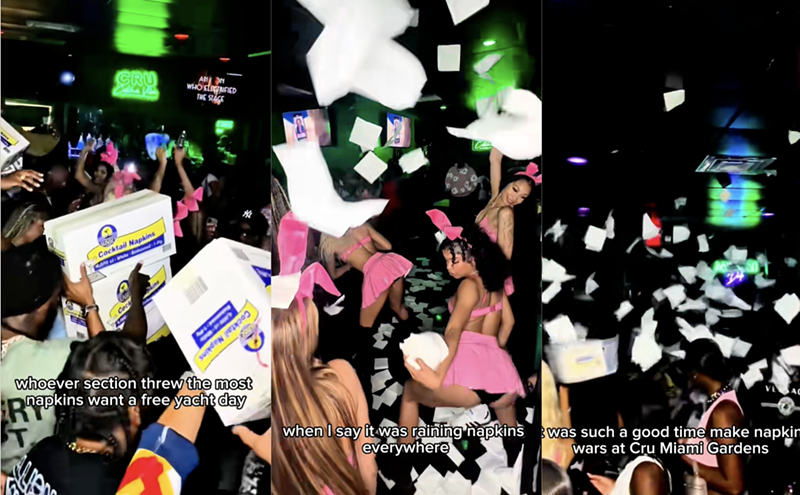When Lindsey Noel Whiting twice takes to the air in Lookingglass Alice, it's easy to forget everything and lose yourself in the rhapsody. Dangling on silks and maneuvering through ropes suspended from the ceiling of the Adrienne Arsht Center's Ziff Ballet Opera House, the young actress eschews all inhibitions, making Alice's delicate circus acrobatics look simple and briefly hypnotizing us into a placid languor.
It's what surrounds these capstone scenes — the other 85 minutes of Lookingglass Alice — that tests our collective patience. Unshapely and not half as funny as it thinks it is, the production provides maximal befuddlement and minimal comprehension, livened only by its playful theatrical ingenuity. The story contains no underlying drive, leaving us little reason to care about anything that happens onstage. It's all sound and humor signifying nothing, and the operative question surrounding the play's existence is "What the hell am I watching?"
It's rarely anything more than a vibrant bauble, pretty and disposable.
tweet this
To be fair, the production, imported from Chicago's Lookingglass Theatre, is based on Lewis Carroll's Alice series, mashing together characters and episodes from Alice's Adventures in Wonderland and Through the Looking Glass — trippy head-scratchers that often spurred the rhetorical question "What the hell am I reading?" David Catlin, who adapted Carroll's words and directed this ambitious, Brechtian reimagining, isn't the first to stumble through a translation of works that should remain tethered to the page; many have tried to visualize Carroll's prose, and few have fully succeeded.
Presumably, Catlin's concept for Lookingglass Alice is to remix Carroll for a postmodern demographic, transforming the literary fantasy into a winking, site-specific theatrical experiment for a 21st-century audience. Ticketholders enter a curiously empty Ziff Ballet Opera House and walk directly onstage through an opening in a giant mirror: They walk through the looking glass. Seats are crammed onto either side of a performance space, which in the play's prologue consists only of a faux vanity mirror, cutely toying with our sense of perception.
An impenetrable black curtain divides Alice, on one side of the audience, from Lewis Carroll himself (Samuel Taylor) on the other side. When the creator discovers his creation through the mirror, the illusion collapses: The curtain falls, house lights blind us at full blast, Arsht Center crew members prepare for a scene change, and the sound technician, in full view, cues the White Rabbit (Kevin Douglas) for his big entrance.
Regularly puncturing its own spectacles, the rest of the play maintains a cheeky balance between onstage and backstage, like a magician revealing his tricks. Soon enough, a bewildered Alice plummets down a "rabbit hole" — a suspended circus hoop — above a sea of tears, presented as a pair of rippling blue sheets controlled by cast members. She meets the White Queen (Taylor), who speaks in an arbitrary Irish brogue, and the Red Queen (Molly Brennan), an impetuous giant who wears a drapey red dress as she towers over the audience.
The plot, such as there is one, is lifted from Through the Looking Glass: Alice must navigate a procession of eight chess squares, each one offering a unique challenge, before she can become a queen. The characters she encounters are taken from both Carroll texts, performed by Lookingglass Theatre's indefatigable four-person ensemble. They include the Mad Hatter (Kevin Douglas), the White Knight (Taylor, clad in a text-covered suit with a modified hockey helmet), a three-person Caterpillar (Douglas, Brennan, and the single-named Adeoye), and the Dormouse (Brennan). Each time Alice moves forward a square, those blinding house lights flash and pop, as if briefly jolting us awake from a continuous, meandering dream.
As the show's seemingly endless reservoir of props and costumes attests, Lookingglass Theatre spared no expense in realizing Catlin's vision. At its best, this vision brings elements of wondrous aerial showmanship and gasp-inducing danger to the normally safe confines of regional theater, from Lewis Carroll appearing upside down from the venue's ceiling to Humpty Dumpty (Douglas) suffering his inevitable fall from a 20-foot ladder.
More often than not, though, the proceedings are plodding and self-indulgent. The excruciating Tea Party sequence stops dead whatever momentum the show had gained. A visit with Tweedledee and Tweedledum, who are imagined as a socially inept hip-hop duo, lands with a desperate thud, another waste of time and talent. (And it doesn't help that when the actors are not miked, their voices are often drowned out by the musical score and other ambient sounds.)
The show's target audience is as nebulous as its narrative, failing to strike the one-size-fits-all balance of the source material. Some of the diction, like "frabjous" and "galumphing," will fly over young audiences, as will some of the inside-theater jokes (at one point, Alice is prompted to sign a waiver before continuing her odyssey). But the humor is juvenile slapstick — characters stepping on one another, falling off unicycles, playing with brightly colored exercise balls, and the like. Lookingglass Alice is as bereft of adult nourishment as it is chockablock with theatrical invention. It's rarely anything more than a vibrant bauble, pretty and disposable.
Perhaps the most consistent criticism of the experience, however, lies solely with the Arsht and not with Lookingglass Theatre. One expects a certain level of comfort when one purchases a $65 theater ticket, but the hard black chairs placed on the Ziff stage are merciless and unforgiving, leaving audience members longing for the comparative luxury of the proper theater seats just below the stage.
Moreover, in an attempt to sell as many tickets as possible, the seats are jammed next to each other without any breathing room, prompting all but the pencil-thin to rub against strangers. Lookingglass Alice isn't worth that kind of hassle.












